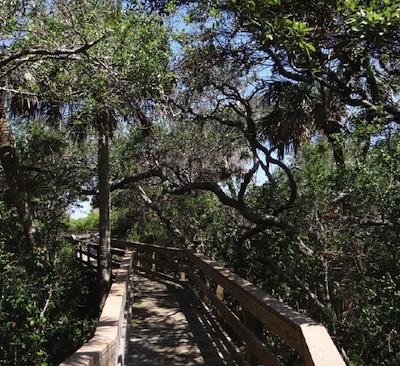
A boardwalk helps you explore the Turtle Mound at Canaveral National Seashore/NPS.
Though Florida is one of the most populated states in the country, there still are places where you can flee humanity in the Sunshine State. Canaveral National Seashore, just north of the Kennedy Space Center, is one of them.
Here on the Atlantic Coast the seashore's beaches draw surfers, swimmers, surfcasters...and turtles...lots of turtles. While Cape Hatteras National Seashore in North Carolina might count 250 turtle nests in one season, at Canaveral nearly 8,000 nests were counted in 2013, the most of any unit in the National Park System. So attractive are the seashore's beaches to sea turtles that last year each kilometer of beachfront averaged more than 200 nests.
The four species that nest here' Loggerhead, Green, Leatherneck, and the occasional Kemp's Ridley'are all important, require protection, and need the seashore's nesting grounds.
But the seashore's riches are more than just biological. Here, along the longest undisturbed stretch of barrier island on the Florida coast (24 miles), there are 150 documented archaeological sites within the seashore, including 40-foot Turtle Mound, one of the tallest Native American shell mounds on the east coast of Florida. Ranging some 600 feet long, this pile of shells'an estimated 1.5 million bushels'was thought to have once stood 75 feet high before years of erosion and modern human activity. Dating back to 800 AD, the midden is constituted mainly of oyster shells, a key food source for the Timucuan Indians.
More shell mounds can be found at Seminole Rest not far from Oak Hill. Snyder's Mound, which dates back to 2,000 B.C., is set on the shores of Mosquito Lagoon. This mound of clam shells stretches about 740 feet long, 340 feet wide, and about 13 feet high. More recent history can be found at Eldora, a late-19th century agricultural community built near Mosquito Lagoon. Residents grew pineapple, citrus fruits, and even olives. Today you can tour the Eldora State House, where inside you can imagine life here through the photos and some artifacts.
Don't overlook the seashore's hardwood hammock forests and mangrove islands to get a good feel for the seashore's diversity. And if you're a birder, time your visit and you might encounter hundreds of thousands of ducks and coots, and migrating and wintering shorebirds drawn to the mudflats along Mosquito Lagoon.
If You Go
Winter is the busy season in Florida. If you head to Canaveral during those months, or even the summer slow season, avoid crowds by choosing a destination other than the Apollo District on weekends. Mosquito Lagoon, and historic Eldora and Seminole Rest, are good bets for losing the crowds.
Want to spot a sea turtle? Join one of the seashore's Turtle Watch Programs, in which rangers take groups out at night to watch female turtles lay their eggs. Manatees and bottle-nose dolphins are frequent visitors to Mosquito Lagoon.



Add comment